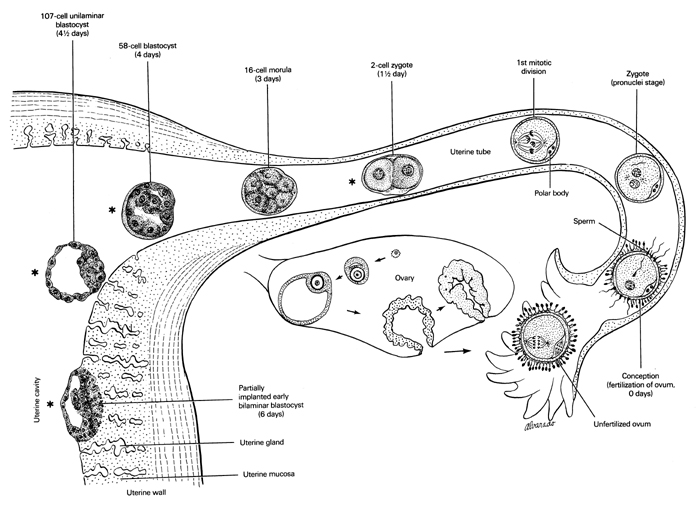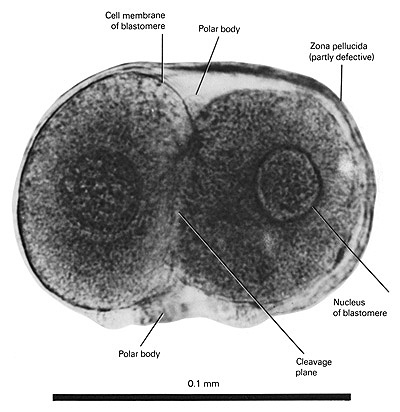raymond f. gasser
ATLAS OF HUMAN EMBRYOS
Copyright © 1975 RF Gasser, PhD. All rights reserved. Reproduced with permission.Chapter I (Pages 1-6)
the first week of life
conception to implantation period
I. CONCEPTION (FERTILIZATION)
Fig. 1–1Conception is the process whereby one male gamete (sperm) fuses with one female gamete (ovum) resulting in a new cell called the zygote. Since each gamete contains 23 chromosomes (1n), the diploid number (2n) of 23 pairs is restored in the embryo. The sex of the new individual is determined at the moment of conception by the type of sex chromosome in the male gamete. The zygote contains genetic information from both parents.
Conception occurs in the infundibular region of the uterine tube. The ovum is surrounded by a thick layer of glycoprotein called the zona pellucida. Sperm become firmly attached to the zona pellucida. After one sperm enters the ovum, permeability of the zona pellucida changes preventing other sperm from entering.
One male and one female pronucleus is formed within the one-cell zygote. The second meiotic division of the ovum is completed resulting in the production of a second polar body. Duplication of the inherited information (DMA) that resides in each pronucleus produces the 4n amount in the cell.
The spindle of the first mitotic division forms. Each paternal and maternal chromosome splits longitudinally with each half moving in a random fashion to opposite poles of the cell.
The one-cell zygote separates into two cells (Fig. 1–2), each containing a nucleus with the identical amount (2n) of inherited information (DMA). Cleavage begins with the formation of the two-cell zygote (schizolig).
II. CLEAVAGE
Figs. 1–1, 1–2, 1–3ACleavage is defined as a rapid succession of mitotic divisions resulting in the production of a progressively larger number of increasingly smaller cells called blastomeres.
Cleavage occurs in the zygote as it makes its way through the uterine tube to the uterine cavity. No true growth occurs since there is no increase in protoplasmic volume but only an increase in the number of cells.
The mass of cells reaches the uterine cavity when it is composed of approximately 16 cells. It has the appearance of a mulberry and is referred to as a morula. The cells in the center of the mass are called collectively the inner cell mass and will give rise to the embryo proper. The surrounding cells at the surface are called collectively the outer cell mass and will give rise to the extraembryonic membranes.
III. BLASTOCYST FORMATION
Figs. 1-1, 1-3BThe physical appearance of the morula changes when it enters the uterine cavity. Fluid collects between the inner and outer cell masses causing the inner cell mass to lie in an eccentric position. A cavity is thus formed called the blastocoele. The entire mass of cells is then referred to as a unilaminar blastocyst.
The zona pellucida disappears as the blastocoele enlarges. Cells of the outer cell mass flatten and collectively form the trophoblast. The inner cell mass becomes the embryoblast which lies at the embryonic pole of the blastocyst.

FIG. 1–1
The stages of development during the first week and the general location of each in the uterine tube or uterus.
Specimens so marked (*) are illustrated elsewhere. [printable version of FIG 1-1]
IV. IMPLANTATION
Figs. 1–1, 1–4Implantation is defined as the process whereby the blastocyst attaches to and erodes through the epithelial lining of the uterus (endometrial epithelium). The erosion of the epithelium is accomplished by the trophoblast, which allows the blastocyst to subsequently invade and embed in the underlying tissue (endometrial stroma).
Attachment occurs at the embryonic pole, probably around 6 days. Attachment usually occurs between the surface openings of the uterine glands.
The trophoblastic cells in contact with the endometrial stroma lose their cell boundaries and form a syncytium. This layer of trophoblastic cells is called the syncytial trophoblast (syncytiotrophoblast). Trophoblastic cells adjacent to the blastocoele retain distinct boundaries and form a thin, single layer of cells called the cellular trophoblast (cytotrophoblast). Small cells known as extraembryonic mesoblasts begin to differentiate in situ on the inner surface of the cellular trophoblast. The amniotic cavity begins as a cleft between the embryoblast and cellular trophoblast.
With the appearance of the amniotic cavity the embryoblast becomes the embryonic disc. The embryonic disc consists of two layers, the epiblast and endoderm. The epiblast is a thick layer of potential ectoderm and mesoderm. The endodermal cells border the blastocoele. Because of the two-layered embryonic disc the entire mass of cells is called a bilaminar blastocyst.

FIG. 1–2
The 2-cell zygote (schizolig)
Stage 2
Age 36 hours (1.5 days)
Carnegie collection 8698
Reference
Hertig AT, Rock J, Adams EC, Mulligan WJ: On the preimplantation stages of the human ovum: a description of four normal and four abnormal specimens ranging from the second to the fifth day of development. Contrib Embryol Carnegie Instn 35:199–220, 1954 [printable version of FIG 1-2]

FIG. 1–3
A. The 58-cell blastocyst
Stage 3
Age 96 hours (4 days)
Carnegie collection 8794
Reference
Hertig AT, Rock J. Adams EC, Mulligan WJ: On the preimplantation stages of the human ovum: a description of four normal and four abnormal specimens ranging from the second to the fifth day of development. Contrib Embryol Carnegie Instn 35:199–220, 1954 [printable version of FIG 1-3]
B. The 107-cell (unilaminar) blastocyst
Stage 3
Age 108 hours (4.5 days)
Carnegie collection 8663
Reference
Hertig AT, Rock J. Adams EC, Mulligan WJ: On the preimplantation stages of the human ovum: a description of four normal and four abnormal specimens ranging from the second to the fifth day of development. Contrib Embryol Carnegie Instn 35:199–220, 1954 [printable version of FIG 1-3]

FIG. 1-4
The partially implanted (bilaminar) blastocyst with the adjacent uterine wall Stage 5 Age 7 days
Carnegie collection 8020 Reference
Hertig AT, Rock J: Two human ova of the previllous stage, having a developmental age of about seven and nine days respectively.
Contrib Embryol Carnegie Instn 31:65-84, 1945 [printable version of FIG 1-4]
